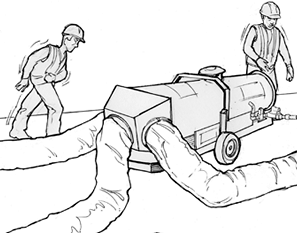
Image from WorkSafeBC’s Workers poisoned by carbon monoxide while using heater
Carbon monoxide poisoning tends to be more of a risk during the cold – at home and at work – when people use gas-powered heaters and even charcoal barbecues to stay warm.
One weekend in Toronto, during the December ice storm, there were 110 emergency calls related to carbon monoxide poisoning, according to this CBC story.
It can also happen at the workplace, as described in this recent hazard alert from WorkSafeBC – Workers poisoned by carbon monoxide while using heater. When a propane valve was not locked into place properly, the flow pressure dropped too low, which put higher than normal amounts of carbon monoxide into the heater’s exhaust gases.
“Carbon monoxide quickly reached hazardous levels inside the building, making the workers dizzy and nauseous,” reads the hazard alert. “The manufacturer’s instructions for the heater stated that the valve handle should be locked into position. The instructions also said that if the heater was used indoors, the exhaust gases must be vented to the outdoors. These instructions were not followed.”
I told a construction worker about this story – and was surprised what he told me in reply. That very day, he had been at work and smelled a gas leak coming from the connection to a heater used for roofing. He stopped the operator, told him to check the propane connection, and they found it was leaking, and re-connected it properly. I commended him for his heads-up response.
This same worker mentioned his concerns regarding Silica – a common substance found in sand, rock, and building materials such as concrete and brick. Cutting, grinding, or drilling these materials releases dangerous crystalline silica dust into the air. This video shows how breathing in silica dust can cause permanent damage to the lungs.
Pre-job safety inspections
A construction safety officer (CSO) from BCIT told me about pre-job safety inspections at PCL, where he worked in the past before moving into building management.
“When using any supplied equipment, we were expected to follow the manufacturer’s instructions, and to be aware of them. There was never any good excuse for not following them,” he said.
“When working in an enclosed area, with equipment like this we always had to have an air quality monitor, a hand-held digital device that could be programmed to detect a number of gases including carbon monoxide, carbon dioxide, or hydrogen sulphide — also oxygen levels. It comes down to supervision and instruction.”
More information on carbon monoxide is available from the Canada Safety Council and in this CBC article Carbon monoxide scare prompts safety investigation.



Timely blog entry! It’s pretty chilly out here in Alberta right now!
Kudos to that construction worker for realizing something wasn’t right and saying something to make it right!
I have multiple crews using heaters to keep inside work spaces workable right now, good info to pass onto supervisors.
Thanks for passing it on.